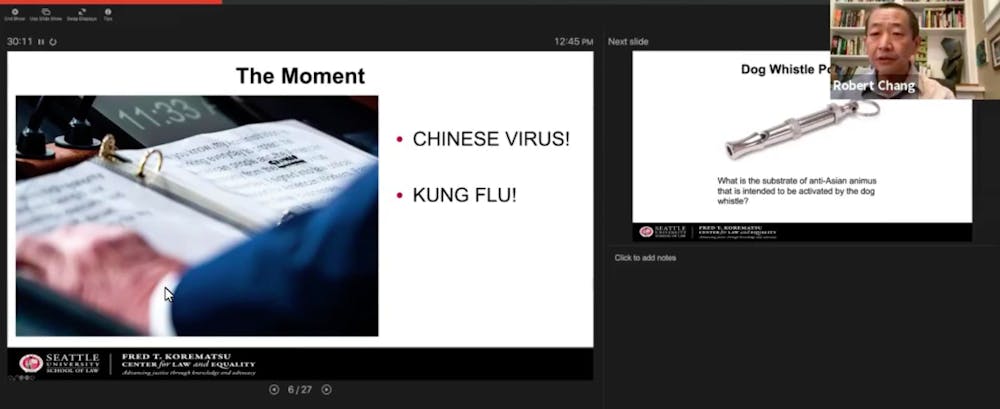In its second Digital Diversity Days, The Office of Multicultural Affairs (OMA) hosted an event, titled “What Does Critical Race Theory Have to Do With Asian Pacific Americans?” on Thursday, April 23. The event, which was broadcasted via Zoom, featured Robert Chang, executive director of the Fred T. Korematsu Center for Law and Equality.
The Digital Diversity Days series are virtual programs dedicated to discussing how Critical Race Theories impact various racial identities. Critical Race Theories provide a framework for researchers and policy-makers to have a race-conscious approach when understanding educational inequality and racism in order to find solutions to these issues.
At the Korematsu Center, Chang works on analyzing racial issues, such as the treatment of Native Alaskan foster children and impact of climate change on minority communities, to combat discrimination and aid marginalized communities.
Chang discussed several landmark cases and policies that institutionalized discrimination against Asian Americans, such as the 1882 Chinese Exclusion Act, Chae Chan Ping v. United States (1889), the 1917 Asiatic Barred Zone Act and the 1924 Immigration Act.
He also addressed the model minority myth, which characterizes Asian Americans as a law-abiding group that achieves higher levels of success through innate talent and hard work ethic.
“This idea of the model minority [lumps] Asian Americans into this category that is intended [not only] to divide but also to erase the tremendous discrimination [and] inequalities that exist within Asian American communities,” Chang said.
He explained that one way of thinking about race in the U.S. is as a racial dyads, such as “white and non-white” or “black and non-black.” Chang believes such thinking creates perverse incentives in litigation strategies.
As an example, Chang cited the Supreme Court of the United States case of Lum v. Rice (1927). Nine-year-old Lum was denied entry to a segregated school in Mississippi, and her attorney pursued an alternative strategy of fighting for Lum’s rights.
“The argument they put forward was, ‘well, she’s not black, and because she’s not black, she should be able to go to the white school,’” Chang explained.
Chang also noted that racial dyads often appear in the racialization of Latinx communities as well. An example of this was in the district court case In re Rodriguez (1897), where the court ruled that Mexicans were “legally white” for the purposes of the immigration statute.
Chang believes many previous court cases were short-sighted, focusing on racial dyads rather than the notion of supremacy of a certain group.
He added that different racial perceptions can be used for political gains, stating that Asian Americans have been used as “racial mascots” by American politicians. Chang cited former Congressman Dana Rohrabacher (R-CA) as an example. Rohrabacher argued against affirmative action on the basis it that it harmed the Asian American community in order to roll back the policy, yet at the same time, he was openly anti-immigrant.
Chang related these theories to the present coronavirus (COVID-19) pandemic.
Chang refers to the public’s use of racially-charged terms, such as the “Chinese virus” and “Kung Flu,” to describe COVID-19 as an example of dog whistle politics, or racially-coded language.
“The fertile ground in terms of the danger of words like ‘Chinese virus’ is that it invokes and appeals to the notion that people of Asian American ancestry [and] Asian ancestry in the United States as being [forever] foreign,” he said.
Chang also expressed his disappointment with former Democratic presidential candidate Andrew Yang’s Op-Ed in The Washington Post on April 1. Like Chang, many criticized Yang’s article for insinuating Asian Americans have to “prove” their Americanness.
Chang concluded the event by explaining his visions of a course correction. He advocated for better education about the history and impact of anti-immigration laws and more informed participation in the political sphere.
In an email to The News-Letter, Director of the OMA Joseph Colón expressed his satisfaction with the second session and public reception of the Critical Race Theories series.
“I hope our attendees understand that the [Asian Pacific Islander Desi American] community is not a monolith and are contending with serious issues that affect them politically, economically, and societally,” Colón wrote. “Professor Chang challenges us to do the critical analysis and homework that is needed to create opportunity for a more equitable and just society.”
The final session of Digital Diversity Days will be held on Thursday, April 30 with a focus on Latino/a/x Critical Race Theory.
Jackie Rittenhouse contributed reporting to this article.





